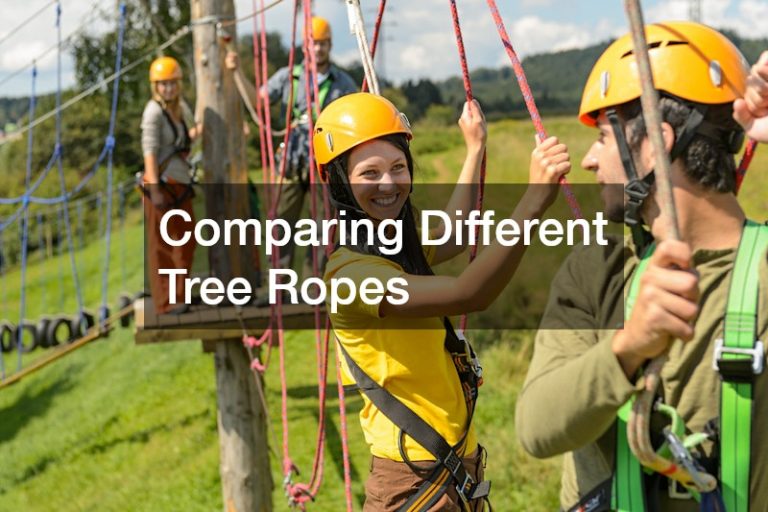Tree ropes are essential tools used by arborists, landscapers, and outdoor enthusiasts to assist in climbing, securing, and performing various tasks related to trees. Whether you are trimming branches, setting up a tree stand, or using them for tree rescue operations, choosing the right tree rope can make all the difference. With so many different types of tree ropes available, it’s crucial to understand their features, strengths, and weaknesses to ensure they meet your specific needs. In this article, we will compare different types of tree ropes, their uses, and the factors to consider when selecting the right one for the job.
One of the most important aspects of tree ropes is their material composition. Traditionally, tree ropes were made from natural fibers like hemp or cotton. However, modern ropes are typically made from synthetic materials such as nylon, polyester, and polypropylene. Each material has its unique properties, such as strength, flexibility, and resistance to environmental factors. For example, nylon is highly durable and resistant to abrasion, making it ideal for heavy-duty tasks. Polyester, on the other hand, is more resistant to UV rays and moisture, which makes it a better choice for outdoor use, especially in environments with exposure to sun and rain.
Nylon tree ropes are a popular choice due to their high tensile strength and ability to absorb shock. These ropes are ideal for climbing applications where the rope will bear heavy loads or absorb the force of a fall. Nylon tree ropes tend to stretch under pressure, which can provide added protection for climbers in case of a fall by reducing the impact force. However, the stretching can also be a disadvantage in certain applications where minimal stretch is preferred. Nylon ropes can be more susceptible to UV degradation and moisture absorption, which can weaken the rope over time if not properly maintained.
Polyester tree ropes, in contrast, have low stretch and offer greater stability during use. This lack of stretch is beneficial for situations where precision and control are critical, such as rigging and setting up a tree stand. Polyester also excels in outdoor conditions as it resists UV rays and water damage better than nylon, making it an excellent choice for long-term use. These ropes are often used in rigging applications, where minimal elongation is essential for maintaining control over the load. While polyester is resistant to most environmental factors, it is not as shock absorbent as nylon, so it may not be the best option for climbing ropes where fall protection is necessary.
Polypropylene tree ropes are another option, offering excellent resistance to moisture and a lighter weight compared to nylon and polyester. These ropes are often used in situations where the rope needs to float, such as in marine environments or when working around bodies of water. Polypropylene is less durable than nylon and polyester and tends to degrade quicker when exposed to UV light, but it is still useful for short-term applications. Due to its lightweight nature, polypropylene ropes are easier to handle and carry, which makes them a good option for recreational purposes like tree swings or outdoor play equipment.
The construction of the tree rope is also an important factor to consider. Ropes can be braided, twisted, or kernmantle, each offering different benefits. Braided ropes are made by interweaving strands of rope to form a smooth, flexible material that is easy to handle and resistant to wear. These ropes are commonly used in climbing applications where flexibility and comfort are necessary. Twisted ropes are made by twisting fibers together to create a rope with a more textured surface. These ropes are often less flexible than braided ones but offer a firmer grip, making them ideal for tying knots or securing loads.
Kernmantle ropes are another popular option for tree ropes. These ropes are made with a strong core (kern) surrounded by a protective outer sheath (mantle). The kern provides strength, while the mantle protects the core from abrasion and environmental damage. Kernmantle ropes are known for their durability, flexibility, and resistance to fraying, making them suitable for climbing, rigging, and rescue operations. They are often used in high-stress environments where both strength and abrasion resistance are required, such as tree removal or rescue missions.
When choosing the right tree ropes, it’s important to also consider their diameter and length. The diameter of the rope affects its strength, weight, and ease of handling. Thicker ropes generally offer more strength but can be heavier and harder to handle, while thinner ropes are lighter and more maneuverable but may not support as much weight. The length of the rope should be selected based on the specific task at hand. Climbing ropes, for example, may require a longer length to reach higher branches, while rigging ropes used for securing equipment may be shorter for easier control.
In addition to the material, construction, diameter, and length, you should also consider the rope’s breaking strength and work load limit (WLL). Breaking strength refers to the maximum force the rope can handle before it breaks, while the WLL is the maximum force the rope can handle during normal use without becoming compromised. These ratings are especially important for safety-critical applications like climbing and rigging, where the rope must hold up under heavy loads or the force of a fall.
In conclusion, tree ropes come in a wide variety of materials, constructions, and specifications, each designed for specific uses and environments. Choosing the right tree rope depends on factors such as the type of work being performed, the environmental conditions, and the rope’s strength requirements. By understanding the differences between nylon, polyester, and polypropylene ropes, as well as the various construction methods and safety considerations, you can select the ideal rope for your tree-related tasks. Whether you’re climbing, rigging, or securing loads, using the appropriate tree rope will ensure safety, efficiency, and long-lasting performance.
.




